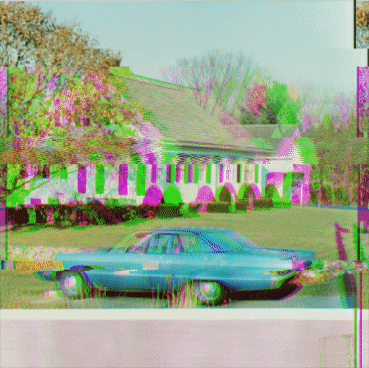Image Glitcher ()

[sketch]
- Tools: Python
- Source code: https://github.com/vec2pt/py-sketches
- Inspirations:
* Images used to test the code taken from the USC-SIPI Image Database.

import matplotlib
import matplotlib.animation as animation
import matplotlib.pyplot as plt
import numpy as np
from PIL import Image
matplotlib.use("TkAgg")
class ImageGlitcher:
"""Image Glitcher"""
def __init__(
self,
img_path: str,
v_glitch: bool = True,
v_intensity: float = 0.01,
h_glitch: bool = True,
h_intensity: float = 0.1,
h_lines_count: int | None = None,
) -> None:
"""Image Glitcher
Args:
img_path (str): Image path.
v_glitch (bool, optional): Vertical glitch. Defaults to True.
v_intensity (float, optional): Intensity of vertical glitch. Defaults to 0.05.
h_glitch (bool, optional): Horizontal glitch. Defaults to True.
h_intensity (float, optional): Intensity of horizontal glitch. Defaults to 0.1.
h_lines_count (int, optional): Number of horizontal glitch lines. Defaults to None.
"""
img = Image.open(img_path)
self._img = np.asarray(img.convert("RGB"))
self._img_shape = self._img.shape
self._v_glitch = v_glitch
self._v_intensity = v_intensity
self._h_glitch = h_glitch
self._h_lines_count = (
h_lines_count if h_lines_count else np.random.randint(2, 21)
)
self._h_intensity = h_intensity
def _get_merged_channels(self, randomization: bool = True):
if randomization:
return np.random.choice(3, size=3, replace=True).tolist()
return [0, 1, 2]
def _get_random_transformation(self, line_length: int, intensity: float):
return np.random.randint(
-int((line_length + 1) * intensity / 2),
int((line_length + 1) * intensity / 2),
)
def glitch(self) -> np.ndarray:
"""Glitch
Returns:
np.ndarray: Glitched image.
"""
new_img = np.copy(self._img)
new_img = np.moveaxis(new_img, -1, 0)
# Vertical glitch
if self._v_glitch:
merged_channels = self._get_merged_channels()
transformations = [
self._get_random_transformation(
self._img_shape[0], self._v_intensity
)
for _ in range(3)
]
for i in range(3):
new_img[i] = np.roll(
new_img[i], transformations[merged_channels[i]], 0
)
# Horizontal glitch
if self._h_glitch:
horizontal_lines = np.sort(
np.random.choice(
self._img_shape[0] + 1,
size=self._h_lines_count - 1,
replace=False,
)
).tolist()
# Common color scheme
merged_channels = self._get_merged_channels()
for a, b in zip(
[0] + horizontal_lines, horizontal_lines + [self._img_shape[0]]
):
transformations = [
self._get_random_transformation(
self._img_shape[1], self._h_intensity
)
for _ in range(3)
]
# Random color scheme for each line
# merged_channels = self._get_merged_channels()
# Randomly glitches some lines
if np.random.choice(2):
for i in range(3):
new_img[i][a:b] = np.roll(
new_img[i][a:b],
transformations[merged_channels[i]],
1,
)
if np.random.choice(2):
for i in range(3):
for j in range(b - a):
new_img[i][a + j] = np.roll(
new_img[i][a + j],
int(np.sin(j * 4) * 5), # WIP
0,
)
return np.moveaxis(new_img, 0, -1)
if __name__ == "__main__":
# np.random.seed(0)
fig, ax = plt.subplots()
ims = []
image_glitcher = ImageGlitcher("house.tiff")
for i in range(15):
glitched_img = image_glitcher.glitch()
im = ax.imshow(glitched_img, animated=True)
ims.append([im])
ani = animation.ArtistAnimation(
fig, ims, interval=150, blit=True, repeat_delay=0
)
plt.show()